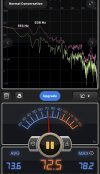I've had a dB meter for a while. I drag it out every now and then but I always wonder about its application and effectiveness. How are you using it? Are you holding it a meter away pointing straight at the speaker? Does anybody have one they swear by? Mine was pretty cheap and I read that the iphone/apps are limited/governed to a dB level that ideally wouldn't work for this application. I tried an app anyway and it did seem like once it got loud, I got the same reading even if the volume increased. Between that and wondering about the way and consistency that I was pointing it at the FRFR (EV ZLX-12BT) I'm wondering how much confidence i could have in the effectiveness of the process.
I just bought the AF3 in late May and I couldn't be happier, getting tons of KILLER tones. My friend that plays in a tribute band decided to take the plunge after hearing mine. We've both been playing for decades and should know better but I'm afraid we fell into the same old story as I've read here many times since searching around, we made some presets that sounded killer in my basement (without a band) at what we figured was above 90dB according to my meter. He unfortunately wasn't able to have a rehearsal before the gig. Pretty much 3 strikes and you're out, right? We took it to the bar anyway, figuring how bad could it be? When we got to the bar, it wasn't horrible by any means, but we both felt that it sounded like a million bucks in my basement, but it sounded meh at the bar. The SRV tone sounded cleaner and seemed to have less low end than in my basement.
Anyway, after that experience he's committed to following the process and having a rehearsal now to fine tune. I'm just trying to help out but also be effective and productive helping my friend and figured I'd fire up another conversation to see if anybody had any eureka moments that could help. If I'm just retreading old news, please ignore.
I just bought the AF3 in late May and I couldn't be happier, getting tons of KILLER tones. My friend that plays in a tribute band decided to take the plunge after hearing mine. We've both been playing for decades and should know better but I'm afraid we fell into the same old story as I've read here many times since searching around, we made some presets that sounded killer in my basement (without a band) at what we figured was above 90dB according to my meter. He unfortunately wasn't able to have a rehearsal before the gig. Pretty much 3 strikes and you're out, right? We took it to the bar anyway, figuring how bad could it be? When we got to the bar, it wasn't horrible by any means, but we both felt that it sounded like a million bucks in my basement, but it sounded meh at the bar. The SRV tone sounded cleaner and seemed to have less low end than in my basement.
Anyway, after that experience he's committed to following the process and having a rehearsal now to fine tune. I'm just trying to help out but also be effective and productive helping my friend and figured I'd fire up another conversation to see if anybody had any eureka moments that could help. If I'm just retreading old news, please ignore.


